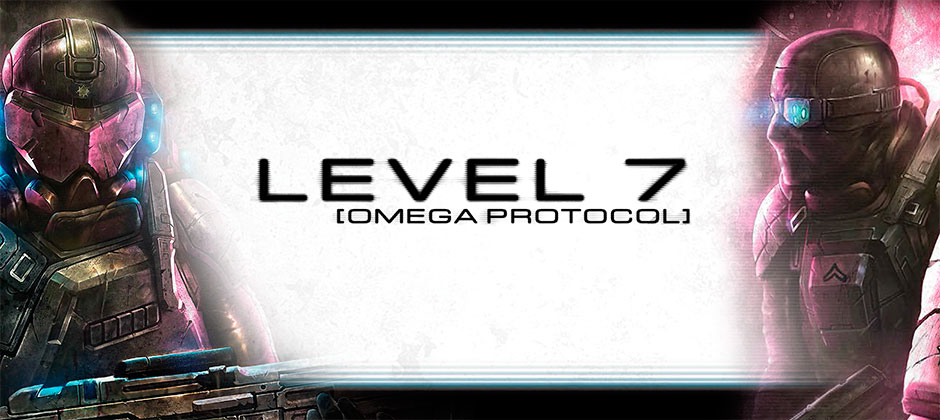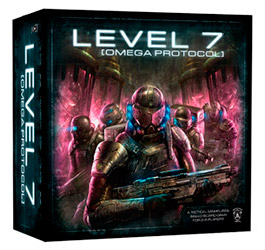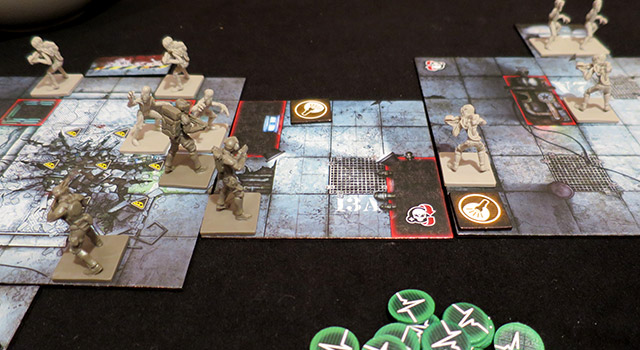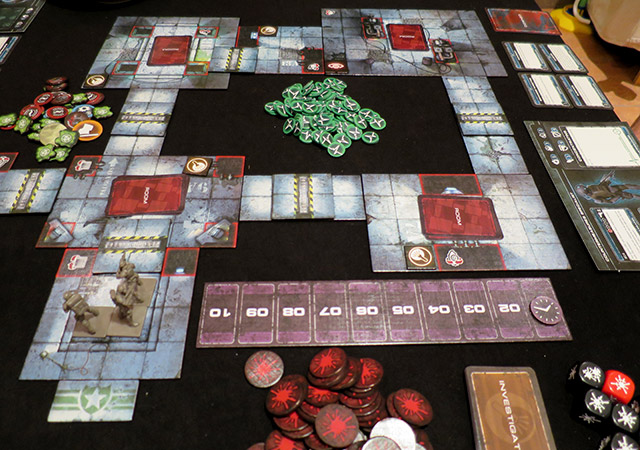
We are not alone
Privateer Press sends you deeper into the mystery of Level 7 by activating Omega Protocol.
 If there’s one type of board game I play (and own) more than any other, it’s dungeoncrawlers. From Heroquest to Descent, Advanced Space Crusade to Claustrophobia, Mutant Chronicles: Siege of the Citadel to Doom: The Boardgame, it doesn’t have to be set in a dungeon (or involve crawling, for that matter) to be called a dungeoncrawl, but it does need some form of map or set of tiles divided into squares (dungeon, alien spaceship, underground bunker), piles of theme, and a goodly handfuls of nicely sculpted miniatures. Once the miniatures are painted, a dungeoncrawl game can come to life like no other.
If there’s one type of board game I play (and own) more than any other, it’s dungeoncrawlers. From Heroquest to Descent, Advanced Space Crusade to Claustrophobia, Mutant Chronicles: Siege of the Citadel to Doom: The Boardgame, it doesn’t have to be set in a dungeon (or involve crawling, for that matter) to be called a dungeoncrawl, but it does need some form of map or set of tiles divided into squares (dungeon, alien spaceship, underground bunker), piles of theme, and a goodly handfuls of nicely sculpted miniatures. Once the miniatures are painted, a dungeoncrawl game can come to life like no other.
But … they can be a bit samey. There’s always a bunch of characters, a bunch of baddies, slight variations on the usual movement, line of sight, and combat rules, and that’s about it. So I initially sighed “here we go again” when I opened the box of Level 7: Omega Protocol and pulled out the map tiles, cards and miniatures. Thankfully however, this new game from Privateer Press, mostly known for their tabletop miniatures systems Warmachine and Hordes, does have a few tricks up its sleeve—most notably a little something called adrenaline.

But before we talk about adrenaline, let’s briefly go over the rules. In L7:OP one player controls the alien clones, and the other players a number of commandos sent to infiltrate and shut down the secret underground government base in which the aliens are running riot. After moving any timer tokens on the round track, each turn starts with the commandos passing any adrenaline they spent last turn to the alien player. I’ll get into that more in a moment. Then, the highest ranking commando assigns each commando an Initiative card that dictates their turn order. Finally, each commando selects a stance card for the turn and places it on their character sheet. This is another interesting and original mechanic—the stance that a commando chooses determines how effective he will be during the round at various styles of play. It adds a welcome bit of pre-planning to a commando’s turn.
There are five different commandos—the team leader, countermeasures specialist, heavy support specialist, rifleman and the reconnaissance specialist—and each has three different stance cards to choose from. For example, the reconnaissance specialist can either sneak, which increases his ranged defense and gives him a reroll against some attacks; make a cautious advance, which allows him to make a move after being attacked and makes his stat checks more effective; or make a reckless advance, which increases his move and gives him a one space move after being attacked. You can see the variety here, and these cards slot on the character sheets to update a commando’s stats for the round. Each commando also has a deck of eight specialised kit cards (and has access to more). So the commandos are working together as a team, each with different skill sets and gear; they’re not just a bunch of characters with slightly different stats and a special ability each.
… the commandos are working together as a team, each with different skill sets and gear…
Now it’s time for the commandos to each take a turn, performing actions (investigate a room, move, use a piece of kit, open a door, heal, trade, revive a fellow commando, and of course attack) by increasing their adrenaline. Each action increases a commando’s adrenaline by a small amount, so, for example, if you want to attack an alien, you have to take two adrenaline tokens. Depending on your stance you have a maximum amount of adrenaline you can take, but you can perform multiple actions up to this limit.
Finally, it’s the alien overseer’s turn. The overseer has a ‘dashboard’ in front of him made up of jigsaw-cut action tiles (the jigsaw diecutting is unnecessary, but it’s a nice touch), each of which has a cut-out ‘well’ in the centre where you place adrenaline tokens as you activate that action (again, the well is unnecessary, but nice). The number and type of actions available to the overseer varies each game. First the overseer refreshes any tokens he has spent in a previous turn (each action refreshes by a certain amount of adrenaline each round), returning those tokens to the main pool. Then he can spend adrenaline to spawn new alien adversaries and activate them: either moving tokens from his own pool (the ones given to him by the commandos) to an action tile well to activate it, or directly paying one token to have an alien move, or a variable amount (depending on the alien) to move and attack. Of course the action tiles aren’t just about spawning new aliens; you can also have an earthquake happen on the base so debris falls on the commandos, or increase the speed or viciousness of your forces—you can even interrupt a commando turn with an attack.
The other clever thing about this system is that it creates a built-in timer for each action if the refresh value is less than the activate value. So some actions can only be taken once every two turns, for example. You can activate an action before it has refreshed, but it means a large adrenaline expenditure! This also means much more meaningful choices for the ‘bad guy’ player—a role that is traditionally less interesting in these types of games.

But the distinctive moment occurs at the start of every commando turn—they must hand over all the adrenaline tokens they used last round to the alien player. Not only is this a neat mechanic—the more actions the commandos take, the more they strengthen the enemy they fight—but the physical act of handing over those tokens is great fun. It’s moments like these that a computer game, on any platform, can never replicate. The commando players always groan as they realise how many tokens they have to give to the alien player, and the alien player always gloats as he receives them and begins to plan the horrors he has in store for the commandos. And when the commandos can see that the overseer is saving up a large amount of tokens, they begin to fear that something terrible is about to happen. Which is, more often than not, a fear completely justified…
The movement and combat rules are pretty standard stuff, with a few quirks to remember. Line of sight is a little weird, and I wish we could all just stick with the good old ‘imaginary line between the centres of the squares’ rule, because Descent 2nd Edition tried to be a bit different as well, and what should be simple just ends up confusing. Facing is important, though the little embossed arrows on the bases of the miniatures are frustratingly difficult to see—a paint job will solve that problem. During setup, the overseer sets up a number of Room card stacks on each room according to the scenario’s instructions, and when a room is investigated, these spawn new enemies, set off traps, reveal vents through which aliens can crawl, and reveal objectives.

The game solves the tricky problem of player elimination by having players ‘downed’ when they lose all their vitality (hit points), but after a pre-determined round near the end of the game—the Crisis Point—the alien player can follow that up with a kill and knock the player out of the game. The Crisis Point usually ramps up the difficulty for the commandos too. The alien player will want to get the commandos very low in vitality as that moment in the game looms, because killing more than half the commandos is usually the condition for an alien win.
The system works well in play, and there’s good increase of tension throughout the game as the commandos try to fulfil their objectives while fending off swarms of aliens. There is a small set of rules for linking the nine scenarios given into a campaign, though the characters don’t develop to a great degree.
…in the crowded genre of dungeoncrawlers, the game pokes its head above the throng and says “play me”
Physically, the game is very well designed. The map tiles could have been a little bit thicker, and the character sheets could have been on the same cardboard weight as the tiles. Unfortunately there’s no box insert, but I’ve already designed one made of foamcore and I’ll make plans for it available here soon.
My only real gripe is that the alien adversaries, and the miniatures for them and the commandos, are a bit nondescript. They would be fine for any other boardgame publisher, but one would think that Privateer Press, a company known for spectacular and characterful miniatures, could have created some more interesting sculpts. They’re perfectly serviceable, but much more ‘boardgame miniatures’ that miniatures in their own right; which is probably partly a matter of cost, and partly a result of the fact that the aliens themselves aren’t very distinctive bad guys. There are little grey men and some strange alien clone hybrid things, but there isn’t really anything particularly impressive and even the largest creature in the game, the Fear Hunter, looks a bit like a mutated camel rather than a terrifying otherworldly beastie.
But in the crowded genre of dungeoncrawlers, L7:OP pokes its head above the throng and says “play me”. Like most games of this type it can take a little too long, but if you’re a fan of this style, you’ll understand how the hours can fly by as you approach another room, trip another ambush, and pick off another horde of bad guys one by one. What you’ll always remember about L7:OP however, is that moment when, as the commandos, you pay the price for all those actions you took on your own turn, and hand over your piles of adrenaline tokens. And as the alien player, you’ll remember laughing maniacally as you take them and begin planning how to share them out amongst your dashboard tiles in order to inflict the most grief possible on those pesky humans.
Well done Privateer Press, for giving dungeoncrawlers a shot of adrenaline.
Be sure to check out my unboxing video, and print out my rules summary and reference sheet to make referring to the rules during play a lot easier. The latter has just been updated to v1.1, and now includes a reference sheet for the overseer’s abilities and effects.
I can see we share a few common habits here. I do put some black on the edges of my cards too. Nice touch.
I do like to black the edges of tiles and counters – always makes them look better against the black felt gaming surface. 🙂
Cool idea, do you use a black marker or paint or what? Also, can we get a sneak peak of the foam core organizer for this game?
Just a black chisel point marker. I’ll have the foamcore insert plans up as soon as I can.
I’d love to see those. I just finished painting the miniatures – now I’m looking for a smart way to store them and all the rest of that stuff.
At the moment my foamcore solution just has a big space to put the minis into – I’ll have to improve that somewhat!
Great review!